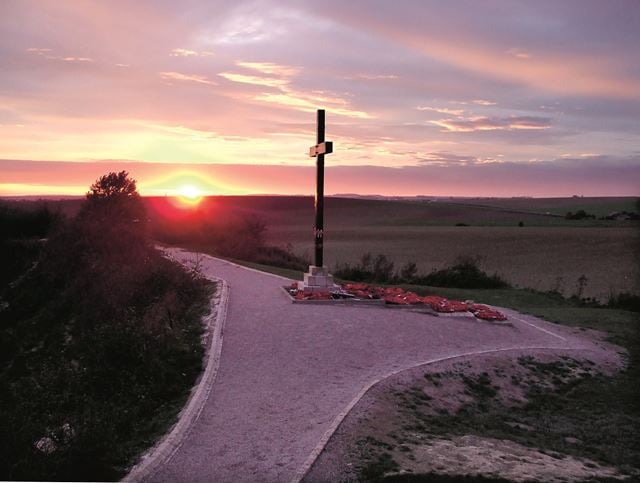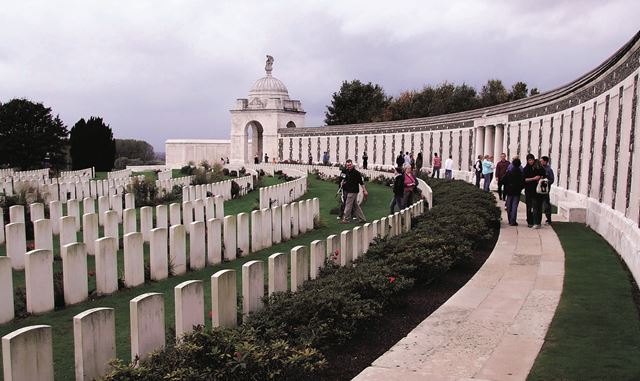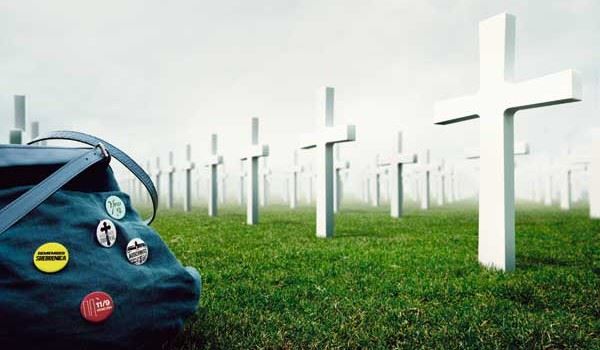Every night at 8 p.m., Belgium’s Menin Gate resounds with the fanfare “The Last Post”. This tribute to fallen soldiers was played for the first time here in 1928 to honour the soldiers who died in the Battle of Ypres, during World War I. Buglers from the city fire brigade have played the fanfare every single night since then, with the exception of a short period during the Second World War. Area residents will often sit out in the evening to hear the fanfare they have heard their whole lives, while visitors stand listening, serious and solemn.

Souvenir shops always follow in the wake of tourism. Dark tourists like to buy red rosettes and enter their personal messages on them.
Photo: Trond Berge
And there are lots and lots of visitors. They are young and old, men and women and from many parts of the Western world. These are dark tourists.
Grief tourism
This phenomenon is known by many names: dark tourism, black tourism, cemetery tourism, battlefield tourism, disaster tourism or grief tourism. Whatever you call it, it is a phenomenon in which people seek out places associated with death and tragedy. Another term is thanatourism, after the Greek word for death, thanatos.
This tourism is motivated by a desire for a real or symbolic encounter with death, an encounter with fatal attractions. And the phenomenon is growing. Some people are attracted to battlefields, while others want to visit to murder scenes or massacre sites. Holocaust tourism can also be counted as part of the trend to some extent. Disaster areas such as Haiti, Ground Zero and New Orleans are also considered in some contexts to be locations for dark tourism.
Some tourists have a personal connection to the places they visit, but not all. Those who flock to theatres of war and memorials from World War I may have a grandfather or an uncle who died in the war. Most have no family ties. There are other things that attract them. Some are on the hunt for new sensations and are attracted by tragedy. Others are attracted by the sadness. They are in search of meaning, and they seek the beauty in remembering those who were mercilessly felled on the battlefield.

The Lochnagar Crater in France was created from a gigantic explosion that preceded the Battle of the Somme. Photo: Trond Berge
Beautiful and sublime
Professor Trond Berge of NTNU’s Department of Social Anthropology has long been interested in this kind of tourism. Anthropologists are interested in this subject and take a perspective that he describes as the aesthetic reduction of the historic. He takes as his starting point the visitor’s quest to experience something beautiful and sublime in the memories of all the horrors that occurred in these places. The contrast between the events and reliving the events is huge.
“What happened during the war has since undergone a kind of double transformation, from the actual event to a monument, from a historical to an aesthetic concern. The horror and dreadfulness of what happened lend themselves to be regarded as a more or less their own source of enjoyment,” says Berge.
Masterpiece of death
Berge is particularly interested in the battlefields along the Western Front, in Flanders, Belgium and Picardy, France. Tourists flock here in huge numbers, and Berge has studied the phenomenon at close range, by travelling on tourist buses from England, which is where some of the battlefield tourists come from.
“The Western Front is the ultimate battlefield. This World War I battlefield represents a kind of modern masterpiece of death and destruction, with such senseless suffering and extreme casualties that it is described as ‘the disaster of the century’, ‘the catastrophe of all catastrophes’ and ‘the ultimate tragedy’. Compared to the Western Front, all other wars are ‘just wars’,” explains Berge.
“People are particularly fascinated by the places where there was all-out total destruction. Visitors immerse themselves in the suffering – or rather, in the memory of the suffering – meaning the suffering and death as they are manifested today in memorials, in death as something that is very much alive,” Berge says. “Many have even said that this is the ‘most beautiful’ thing they have experienced. And I think that’s interesting – what is beautiful, and why is it beautiful?”
A desire for an emotional connection

The largest cemetery for British soldiers on the Western Front is found in Tyne Cot, in Ypres, Belgium. Photo: Trond Berge
Soldiers died in droves on the battlefields of the Western Front. They killed each other with bullets and bayonets, fighting in close quarters, but most of all they killed each other with cannons. The term cannon fodder originated here. The soldiers who survived the war were forever marked by the experience and many were mentally destroyed by their battlefield experiences. The feeling of powerlessness, lying in the trenches waiting for the next attack or the next grenade strike, was extremely stressful.
More than 72000 soldiers died in the brutal battle of the Somme in France, most of them during the summer of 1916. A large battle monument was erected in the village of Thiepval on the Somme, along with a number of cemeteries for the war dead, who were buried near where they fell. Families were not able to bring their dead home. For that reason, Western Front battlefields are characterized by countless numbers of cemeteries, about 2000 in total, marked by row upon row of identical white limestone tombstones. A little of the topography and the installations from the war have been preserved, and tourist groups large and small wander around these places trying to take in the horrors of war, and to keep the memories alive.
“There is something fundamentally tragic about war memorials, something that people want to experience. This kind of tourism is all about exposing yourself to impressions, knowing that this does something to you. People want to be touched,” says Berge.
Witnesses forever
Death and the dead live on in these monuments. And the tourists who come here share a common moral task: They must keep the memories alive. They see themselves as pilgrims and moral witnesses.
“There is tremendous respect and awe in the promise that ‘we will not forget’,” says Berge.
While in previous wars and battles, history was customarily crafted from victories, successes and heroes, World War I was often associated with pointless mass death. Two literary memorials, both from 1929, helped define the war’s meaninglessness for present and future generations: Hemingway’s “Farewell to Arms” and Remarque’s “All Quiet on the Western Front”. Both authors had themselves physically experienced war. The antihero, the young innocent soldier who died so meaninglessly young and for no good reason, became a symbol of war.
“Through battlefield tourism, the powerless victims of the horrors of war are memorialized again and again. Yes, forever. It is precisely this that is experienced as beautiful,” says Berge.
An aesthetic experience
Berge has asked himself what exactly this type of tourism represents.
“It’s about a relational aesthetic, an aesthetic experience where the appeal lies in what things say about yourself in relation to others,” says Berge. The concept of relational aesthetics originated in the 1990s in the art world. Artwork and its understanding accommodates the interactive, the social and the relational. A work of art is evaluated based on the interpersonal relationships it represents.
“It is also about an aesthetic of experience, which relates to how things should be experienced to be a good experience. Things should hurt a little. It is the pain that is experienced as good. I am engaged with the process of how horror is turned into something beautiful, how negative becomes positive, how ugly becomes beautiful, or for that matter, how trash becomes art.”
While the battle was raging
Dark tourism to the Western Front began even before the war was over. Verdun is one of the symbols of the war’s violence. Here, 262 000 human lives were lost, and about half-a-million were injured. Verdun was a hot spot for beautiful people in Paris even while the fighting was still ongoing. Ypres also attracted visitors early on.
Michelin had already produced the first war guidebook by 1917. Another 29 were published during the next four years, of which “The Pilgrim’s Guide to the Ypres Salient” is best known. It is said that the city in the 1920s was a thriving mecca for mass tourism. Since then, the influx has never stopped.
“The most vivid aspect of the First World War is that it happened so long ago. The fact that its memory has survived to today contributes more than anything else to maintaining people’s interest,” says Berge. And now as we approach the 100th anniversary of the various battles of the First World War, dark tourism will probably only increase in the coming years.
The University of Central Lancashire in the UK has its own Institute for Dark Tourism Research.

